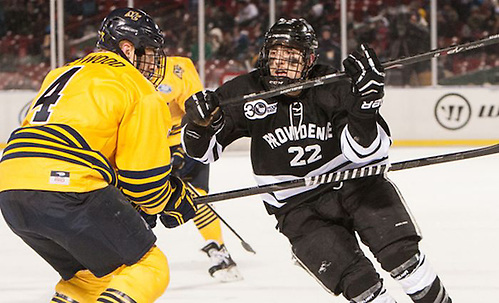
If you want to skip the inner workings and get to the results of the analysis, click here.
It’s time once again to do what we like to call Bracketology, college hockey style. It’s our weekly look at how I believe the NCAA tournament will wind up come selection time.
It’s a look into what are the possible thought processes behind selecting and seeding the NCAA tournament teams.
Those of you that are veterans of the college hockey scene know that it is all about the PairWise Rankings. This is USCHO’s numerical approach that simulates the way the NCAA Division I Men’s Ice Hockey Committee chooses the teams that make the NCAA tournament.
The criteria are tweaked every so often — every so often being every year lately — in order to give what the committee believes will be the best tournament.
There were some major changes this year to the selection criteria. In short:
• PairWise comparisons are now done against all teams. There is no cutoff for the amount of teams, so the most PWR comparison wins that a team can have is 58 since there are 59 teams.
• There is now a home and away wins weighting applied to the Ratings Percentage Index. In calculation of the index, wins on the road and losses at home have a weighting factor of 1.2. Wins at home and losses on the road have a weighting factor of 0.8. All neutral-site games have a weighting factor of 1.0. A tie is one-half of a win and one-half of a loss, so home/road ties are treated accordingly for the teams involved.
• There is a quality wins bonus for wins against teams in the top 20 of the RPI. A win against the No. 1 team in the RPI is worth 0.05 points, and is scaled down by 0.0025 points for each place until you reach No. 20, where a bonus of 0.0025 points will be given.
The changes are a little complicated, so it is best to check out our FAQ.
Since USCHO has begun the PairWise Rankings, we have correctly identified all of the teams that have been selected to the NCAA tournament.
For the past three years, I am the only prognosticator to have correctly predicted the exact brackets for the NCAA tournament, meaning that I have predicted how the committee thought when putting together the brackets.
This is the next installment of our Bracketology, and we’ll be bringing you a new one every week until we make our final picks before the field is announced on March 23.
Here are the facts:
• Sixteen teams are selected to participate in the national tournament.
• There are four regional sites (East — Bridgeport, Conn.; Northeast — Worcester, Mass.; Midwest — Cincinnati; West — St. Paul, Minn.)
• A host institution that is invited to the tournament plays in the regional for which it is the host and cannot be moved. There are four host institutions this year: Yale in Bridgeport, Holy Cross in Worcester, Miami in Cincinnati and Minnesota in St. Paul.
• Seedings will not be switched. To avoid undesirable first-round matchups, including intra-conference games (see below), teams will be moved among regionals, not reseeded.
Here are the NCAA’s guidelines on the matter, from the 2014 pre-championship manual:
In setting up the tournament, the committee begins with a list of priorities to ensure a successful tournament on all fronts, including competitive equity, financial success and the likelihood of a playoff-type atmosphere at each regional site. For this model, the following is a basic set of priorities:
1. Once the six automatic qualifiers and 10 at-large teams are selected, the next step is to develop four groups from the committee’s rankings of 1-16. The top four teams are No. 1 seeds and will be placed in the bracket so that if all four teams advance to the Men’s Frozen Four, the No. 1 seed will play the No. 4 seed and the No. 2 seed will play the No. 3 seed in the semifinals. The next four are targeted as No. 2 seeds. The next four are No. 3 seeds and the last four are No. 4 seeds.
2. Step two is to place the home teams. Host institutions that qualify will be placed at home.
3. Step three is to fill in the bracket so that first-round conference matchups are avoided, unless it corrupts the integrity of the bracket. If five or more teams from one conference are selected to the championship, then the integrity of the bracket will be protected (i.e., maintaining the pairing process according to seed will take priority over avoidance of first-round conference matchups). To complete each regional, the committee assigns one team from each of the remaining seeded groups so there is a No. 1, No. 2, No. 3 and No. 4 seed at each regional site.
Given these facts, here is the top 16 of the current PairWise Rankings (PWR), and the conference leaders through all games of March 11:
1 Minnesota
2 Boston College
3t Union
3t Wisconsin
5 St. Cloud State
6 Ferris State
7 Quinnipiac
8 Massachusetts-Lowell
9 Notre Dame
10 North Dakota
11t Providence
11t Vermont
13 Cornell
14t Michigan
14t Northeastern
16 Colgate
32 Mercyhurst
Current conference leaders based on winning percentage or top remaining seeds:
Atlantic Hockey: Mercyhurst
Big Ten: Minnesota
ECAC Hockey: Union
Hockey East: Boston College
NCHC: St. Cloud State
WCHA: Ferris State
Notes
• Bracketology assumes that the season has ended and there are no more games to be played — i.e., the NCAA tournament starts tomorrow.
• Because the Big Ten is still in regular season play, I’m using winning percentage, not points accumulated, to determine the conference leader. In other conferences, it’s the top remaining playoff seed. This team is my assumed conference tournament champion.
Step one
From the committee’s report, choose the 16 teams in the tournament.
We break ties in the PWR by looking at the individual comparisons among the tied teams, and add in any current league leaders that are not currently in the top 16. The only teams that are not is Mercyhurst.
From there, we can start looking at the ties and bubbles in a more detailed fashion.
The ties and bubbles consist of Union and Wisconsin at 3, Providence and Vermont at 11 and Michigan and Northeastern at 14.
We break all of our ties based upon the RPI.
Therefore, the 16 teams in the tournament, in rank order, are:
1 Minnesota
2 Boston College
3 Union
4 Wisconsin
5 St. Cloud State
6 Ferris State
7 Quinnipiac
8 Massachusetts-Lowell
9 Notre Dame
10 North Dakota
11 Providence
12 Vermont
13 Cornell
14 Michigan
15 Northeastern
16 Mercyhurst
Step two
Now it’s time to assign the seeds.
No. 1 seeds: Minnesota, Boston College, Union, Wisconsin
No. 2 seeds: St. Cloud State, Ferris State, Quinnipiac, Massachusetts-Lowell
No. 3 seeds: Notre Dame, North Dakota, Providence, Vermont
No. 4 seeds: Cornell, Michigan, Northeastern, Mercyhurst
Step three
Place the No. 1 seeds in regionals.
Minnesota, as a host school, is placed first.
No. 1 Minnesota is placed in the West Regional in St. Paul.
No. 2 Boston College is placed in the Northeast Regional in Worcester.
No. 3 Union is placed in the East Regional in Bridgeport.
No. 4 Wisconsin is placed in the Midwest Regional in Cincinnati.
Step four
Now we place the other 12 teams so as to avoid intra-conference matchups if possible.
Begin by filling in each bracket by banding groups. Remember that teams are not assigned to the regional closest to their campus sites by ranking order within the banding (unless you are a host school, in which case you must be assigned to your home regional).
If this is the case, as it was last year, then the committee should seed so that the quarterfinals are seeded such that the four regional championships would be played by No. 1 vs. No. 8, No. 2 vs. No. 7, No. 3 vs. No. 6 and No. 4 vs. No. 5.
So therefore:
No. 2 seeds
No. 8 Massachusetts-Lowell is placed in No. 1 Minnesota’s regional, the West Regional.
No. 7 Quinnipiac is placed in No. 2 Boston College’s regional, the Northeast Regional.
No. 6 Ferris State is placed in No. 3 Union’s regional, the East Regional.
No. 5 St. Cloud State is placed in No. 4 Wisconsin’s regional, the Midwest Regional.
No. 3 seeds
Our bracketing system has one regional containing seeds 1, 8, 9, and 16; another with 2, 7, 10 and 15; another with 3, 6, 11 and 14; and another with 4, 5, 12 and 13.
No. 9 Notre Dame is placed in No. 8 Massachusetts-Lowell’s regional, the West Regional.
No. 10 North Dakota is placed in No. 7 Quinnipiac’s regional, the Northeast Regional.
No. 11 Providence is placed in No. 6 Ferris State’s regional, the East Regional.
No. 12 Vermont is placed in No. 5 St. Cloud’s regional, the Midwest Regional.
No. 4 seeds
One more time, taking No. 16 vs. No. 1, No. 15 vs. No. 2, etc.
No. 16 Mercyhurst is sent to No. 1 Minnesota’s regional, the West Regional.
No. 15 Northeastern is sent to No. 2 Boston College’s regional, the Northeast Regional.
No. 14 Michigan is sent to No. 3 Union’s regional, the East Regional.
No. 13 Cornell is sent to No. 4 Wisconsin’s regional, the Midwest Regional.
The brackets as we have set them up:
West Regional (St. Paul):
16 Mercyhurst vs. 1 Minnesota
9 Notre Dame vs. 8 Massachusetts-Lowell
Midwest Regional (Cincinnati):
13 Cornell vs. 4 Wisconsin
12 Vermont vs. 5 St. Cloud State
Northeast Regional (Worcester):
15 Northeastern vs. 2 Boston College
10 North Dakota vs. 7 Quinnipiac
East Regional (Bridgeport):
14 Michigan vs. 3 Union
11 Providence vs. 6 Ferris State
Our first concern is avoiding intraconference matchups. We have Notre Dame vs. Lowell and Northeastern vs. Boston College.
Since there are three Hockey East teams in the three band, we can only have North Dakota play Lowell. So we swap Notre Dame with North Dakota.
West Regional (St. Paul):
16 Mercyhurst vs. 1 Minnesota
10 North Dakota vs. 8 Massachusetts-Lowell
Midwest Regional (Cincinnati):
13 Cornell vs. 4 Wisconsin
12 Vermont vs. 5 St. Cloud State
Northeast Regional (Worcester):
15 Northeastern vs. 2 Boston College
9 Notre Dame vs. 7 Quinnipiac
East Regional (Bridgeport):
14 Michigan vs. 3 Union
11 Providence vs. 6 Ferris State
Northeastern can only play Union or Wisconsin. So we swap Michigan and Northeastern.
West Regional (St. Paul):
16 Mercyhurst vs. 1 Minnesota
10 North Dakota vs. 8 Massachusetts-Lowell
Midwest Regional (Cincinnati):
13 Cornell vs. 4 Wisconsin
12 Vermont vs. 5 St. Cloud State
Northeast Regional (Worcester):
14 Michigan vs. 2 Boston College
9 Notre Dame vs. 7 Quinnipiac
East Regional (Bridgeport):
15 Northeastern vs. 3 Union
11 Providence vs. 6 Ferris State
OK, time to fine-tune our brackets.
Let’s get all of our teams in the two band closest to home as well. That involves switching matchups instead of just one team.
We’ll move the St. Cloud State-Vermont game to the West, Ferris State-Provdence to the Midwest, Quinnipiac-Notre Dame to the East and Massachusetts-Lowell against North Dakota to the Northeast.
West Regional (St. Paul):
16 Mercyhurst vs. 1 Minnesota
12 Vermont vs. 5 St. Cloud State
Midwest Regional (Cincinnati):
13 Cornell vs. 4 Wisconsin
11 Providence vs. 6 Ferris State
Northeast Regional (Worcester):
14 Michigan vs. 2 Boston College
10 North Dakota vs. 8 Massachusetts-Lowell
East Regional (Bridgeport):
15 Northeastern vs. 3 Union
9 Notre Dame vs. 7 Quinnipiac
How does all this look? Looks good to me. I would love to swap Cornell and Michigan, but I can’t because of the Big Ten matchup. So we have to leave this as is.
So that is it.
See you here next week for the next Bracketology.
Here’s a summary of everything that we have covered.
This week’s brackets
West Regional (St. Paul):
16 Mercyhurst vs. 1 Minnesota
12 Vermont vs. 5 St. Cloud State
Midwest Regional (Cincinnati):
13 Cornell vs. 4 Wisconsin
11 Providence vs. 6 Ferris State
Northeast Regional (Worcester):
14 Michigan vs. 2 Boston College
10 North Dakota vs. 8 Massachusetts-Lowell
East Regional (Bridgeport):
15 Northeastern vs. 3 Union
9 Notre Dame vs. 7 Quinnipiac
Conference breakdowns
Hockey East — 6
ECAC Hockey — 3
Big Ten — 3
NCHC — 2
WCHA — 1
Atlantic Hockey — 1
On the move
In: Northeastern
Out: Minnesota State
Attendance woes?
I do have some concerns now because of the way teams are spread out.
Last week’s brackets
West Regional (St. Paul):
16 Mercyhurst vs. 1 Minnesota
9 North Dakota vs. 5 Wisconsin
Midwest Regional (Cincinnati):
13 Cornell vs. 4 St. Cloud State
12 Michigan vs. 8 Massachusetts-Lowell
Northeast Regional (Worcester):
15 Minnesota State vs. 2 Boston College
10 Notre Dame vs. 6 Ferris State
East Regional (Bridgeport):
14 Vermont vs. 3 Union
11 Providence vs. 7 Quinnipiac
Interesting …
Teams are starting to cement their places in the tournament as you didn’t see much movement at all in the top 10.
Teams will solidify their spots this weekend. After this weekend you’ll also have some interesting positions in Hockey East, as the losers of Boston College vs. Notre Dame and Massachusetts-Lowell vs. Vermont will have to wait a week to see if they get at-larges, which can very well happen.


